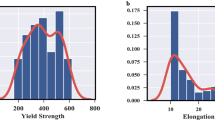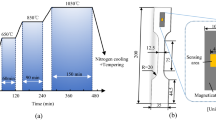Abstract
This study investigates the correlation between various micromagnetic signature patterns and the yield and tensile strengths of carbon steel (Cr12MoV steel as per Chinese standards). For this purpose, back-propagation neural network (BP-NN) models are established to quantitatively predict the yield and tensile strengths of carbon steels. The accuracy of prediction models is significantly affected by the presence of redundant micromagnetic signature patterns. By carefully screening the input parameters, it is able to effectively mitigate prediction errors arising from unreasonable model inputs. In the field of micromagnetic nondestructive testing (NDT), prediction models calibrated for a specific instrument or sensor cannot be directly applied to another instrument or sensor. In the study, a joint distribution adaptation transfer learning strategy based on auxiliary data is proposed to enhance the generalization of prediction models for cross-instrument applications. When auxiliary data accounts for 30% of the source domain data, the joint distribution adaptation transfer learning method based on auxiliary data improves the robustness of the model. The accuracy of the yield strength and tensile strength calibration models witnesses remarkable improvements of approximately 91.4% and 93.5%, respectively.











Similar content being viewed by others
Data availability
The data used to support the findings of this study are available from the corresponding author upon request.
References
Hanke, R.: Fraunhofer Institute for non-destructive testing IZFP—expanding the potential of NDT across the entire product life cycle. In: NDT 2016, Nottingham, pp. 305–308 (2016)
Dobmann, G.: Physical basics and industrial applications of 3MA—micromagnetic multiparameter microstructure and stress analysis. In: ECNDT 2010, Moscow, pp. 7–11 (2010)
Wang, H., Dong, L., Wang, H., Ma, G., Xu, B., Zhao, Y.: Effect of tensile stress on metal magnetic memory signals during on-line measurement in ferromagnetic steel. NDT&E 117, 102378 (2021)
Ding, S., Tian, G., Dobmann, G., Wang, P.: Analysis of domain wall dynamics based on skewness of magnetic Barkhausen noise for applied stress determination. J. Magn. Magn. Mater. 421, 225–229 (2017)
Qiu, F., Jovicevic-Klug, M., Tian, G., Wu, G., McCord, J.: Correlation of magnetic field and stress-induced magnetic domain reorientation with Barkhausen Noise. J. Magn. Magn. Mater. 523, 167588 (2021)
Moorthy, V., Shaw, B.A., Day, S.: Evaluation of applied and residual stresses in case-carburized En36 steel subjected to bending using the magnetic Barkhausen emission technique. Acta Mater. 52(7), 1927–1936 (2004)
Aghadavoudi-Jolfaei, M., Shen, J., Smith, A.: Non-destructive measurement of microstructure and tensile strength in varying thickness commercial DP steel strip using an EM sensor. J. Magn. Magn. Mater. 473, 477–483 (2019)
Ghanei, S., Kashefi, M., Mazinani, M.: Eddy current nondestructive evaluation of dual phase steel. Mater. Des. 50, 491–496 (2013)
Ghanei, S., Alam, A.S., Kashefi, M., et al.: Nondestructive characterization of microstructure and mechanical properties of intercritically annealed dual-phase steel by magnetic Barkhausen noise technique. Mater. Sci. Eng. A 607, 253–260 (2014)
Wang, X., He, C., Li, P., et al.: Micromagnetic and quantitative prediction of surface hardness in carbon steels based on a joint classification-regression method. J. Nondestruct. Eval.Nondestruct. Eval. 41(3), 893 (2022)
Dong, H., Liu, X., Song, Y., Wang, B., Chen, S., He, C.: Quantitative evaluation of residual stress and surface hardness in deep drawn parts based on magnetic barkhausen noise technology. Measurement 168(3), 108473 (2019)
Li, K., Li, L., Wang, P., Liu, J., Shi, Y., Zhen, Y., Dong, S.: A fast and non-destructive method to evaluate yield strength of cold-rolled steel via incremental permeability. J. Magn. Magn. Mater. 498, 166087 (2020)
Wolter, B., Gabi, Y., Conrad, C.: Nondestructive testing with 3MA: an overview of principles and applications. Sci. 9(6), 1068 (2019)
Kahrobaee, S., Haghighi, M.S., Akhlaghi, I.A.: Improving nondestructive characterization of dual phase steels using data fusion. J. Magn. Magn. Mater. 458, 317–326 (2018)
Kahrobaee, S., Kashefi, M.: Microstructural characterization of quenched AISI D2 tool steel using magnetic/electromagnetic nondestructive techniques. IEEE Trans. Magn. 51(9), 1–7 (2015)
Kahrobaee, S., Kashefi, M.: Assessment of retained austenite in AISI D2 tool steel using magnetic hysteresis and Barkhausen noise parameters. J. Mater. Eng. Perform. 24(3), 1192–1198 (2015)
Li, P., Gong, Y., Liang, C., et al.: Effect of post-heat treatment on residual stress and tensile strength of hybrid additive and subtractive manufacturing. Int. J. Adv. Manuf. Technol. 24(103), 2579–2592 (2019)
Wen, X., Xu, Z.: Wind turbine fault diagnosis based on ReliefF-PCA and DNN. Expert Syst. Appl. 178(11), 115016 (2021)
Acknowledgements
We acknowledge the support from the National Natural Science Foundation of China (Project Nos. 11527801, 12122201, and 11872081), Bei**g Nova Program of Science and Technology under Grant Nos. Z191100001119044.
Funding
This study was supported by the National Natural Science Foundation of China (Project Nos. 11527801, 12122201, and 11872081), Bei**g Nova Program of Science and Technology under Grant Nos. Z191100001119044.
Author information
Authors and Affiliations
Contributions
**anxian Wang: Writing—review & editing. **ucheng Liu: Methodology, Writing—review & editing. Cunfu He: Supervision, Funding acquisition, Project administration. Investigation, Software, Formal Analysis, Writing—original draft. Peng Li: Writing—review & editing, Visualization. Zhixiang **ng: Investigation, Software, Formal analysis. Mengshuai Ning: Resources, Validation.
Corresponding author
Ethics declarations
Conflict of interest
All authors certify that they have no affiliations with or involvement in any organization or entity with any financial or non-financial interest in the subject matter or materials discussed in this manuscript.
Ethics approval and consent to participate
Not applicable.
Consent for publication
All authors consent to publication of the research results.
Additional information
Publisher's Note
Springer Nature remains neutral with regard to jurisdictional claims in published maps and institutional affiliations.
Appendix
Rights and permissions
Springer Nature or its licensor (e.g. a society or other partner) holds exclusive rights to this article under a publishing agreement with the author(s) or other rightsholder(s); author self-archiving of the accepted manuscript version of this article is solely governed by the terms of such publishing agreement and applicable law.
About this article
Cite this article
Wang, X., He, C., Li, P. et al. Micromagnetic and Quantitative Prediction of Yield and Tensile Strength of Carbon Steels Using Transfer Learning Method. J Nondestruct Eval 43, 69 (2024). https://doi.org/10.1007/s10921-024-01086-5
Received:
Accepted:
Published:
DOI: https://doi.org/10.1007/s10921-024-01086-5




